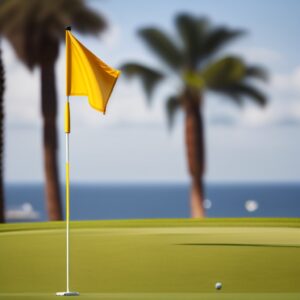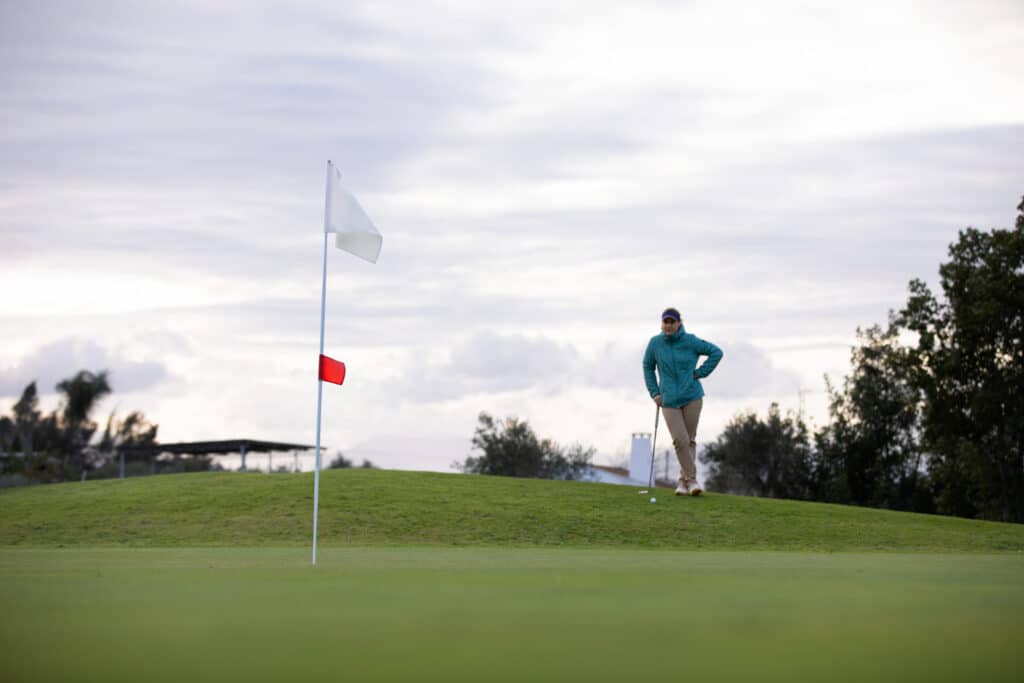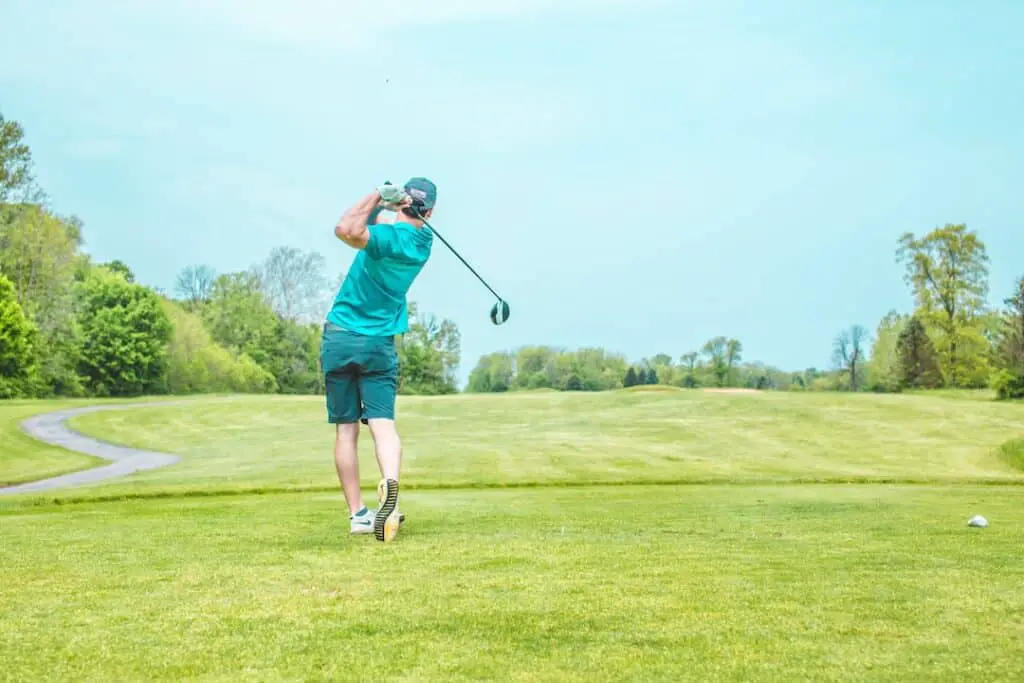Last Updated on June 7, 2023
Golfing in windy conditions can be a daunting challenge for any golfer, novice or experienced. The wind has an array of effects on the game that golfers must learn to recognise and work with if they want to achieve success. This article will provide information on how to play golf in the wind, by discussing techniques used by professionals as well as strategies and methods which can help improve one’s performance when playing under windy conditions.
Read the Wind Direction and Speed
When golfing in windy conditions, it is essential to read the wind speed and direction. Players must take into consideration how strong the airflow is and which way it is blowing before beginning a swing or making any decisions regarding club selection. The most reliable method for reading wind speed and direction is to use an anemometer or weather station that provides up-to-date information on current wind speeds at a given location.
If this technology is unavailable, players can also observe their surroundings; clues like rippling flags, waving trees, and gusts of air are indicators of both direction and strength. Analysing these observations allows golfers to accurately assess the situation they face while playing in the wind. Furthermore, by doing so they can gain insight into which clubs will be more effective based on the complexity of the shot required.
Establish a Low Center of Gravity
Setting up a low centre of gravity is essential for any golfer playing in windy conditions. When the ball is closer to the ground, it will be more stable and not get pushed around by gusts as much. This can help improve accuracy and control, which are both necessary for successful golfing in these types of weather conditions.
To establish a low centre of gravity when golfing:
- Position your feet properly to ensure that most of your weight is on the balls of them whilst keeping good balance;
- Lower your backswing angle slightly so your clubhead travels along an inside-out path through impact;
- Keep your hands lower than usual at address, making sure they’re in line with or even below your waistline;
- Make use of specialised clubs, such as those designed specifically for “centre gravity golf” which feature longer shafts and shorter heads.
These techniques allow you to maintain a lower body position throughout the swing process, creating less energy transfer between different parts of the body while also helping to keep shots more consistent despite changing winds.
Understand How Wind Affects Ball Flight

Wind direction has an effect on the trajectory of a golf ball. Depending on whether the wind is blowing toward or away from the target, it can either help or hinder one’s chances of making a successful shot. When hitting into the wind, players must consider choosing a club with more loft to keep their shots low and reduce the amount of air resistance. On the other hand, when playing downwind, selecting a driver will increase distance due to reduced drag force and increased lift generated by the headwind.
Golfers need to be aware of how varying levels of wind intensity may influence their swings as well as their choice of clubs while out on the course. This knowledge can contribute significantly to improving one’s scorecard over time and reducing errors that are caused by incorrect decisions during play. Players should also take into account any significant changes in temperature or humidity which could impact performance depending on conditions.
Club Selection in Windy Conditions
Club selection can be the determining factor between success and failure. It is important to understand how different clubs will react under various wind speeds to maximise results. Wind speed affects both trajectory and distance of shots, therefore making it essential for a golfer to select an appropriate club for their situation.
When facing wind from left to right (or vice versa), selecting a higher lofted club could reduce ball flight dispersion due to reduced spin on the shot. This allows for better accuracy when hitting into the wind as well as allowing the player more control over their shot. When dealing with strong winds, using a driver can have disastrous consequences as there is very little backspin that can provide stability throughout its path. A three-wood or hybrid may be better suited in this case since they are able to produce less spin than a driver but still carry enough power at impact to reach longer distances down the fairway.
Add Loft to Increase Carry Distance
Adding loft to the clubface is a useful strategy for increased carry distance. Loft refers to the angle of the face of the club when it strikes the ball and can be adjusted by opening or closing the position of the clubhead upon impact to its original address position. When playing a shot into a headwind, opening up the face at address increases loft, which helps keep shots lower and less affected by gusts of wind. Similarly, when hitting into a tailwind, closing down on the clubface reduces lift while still providing adequate spin.
Take Advantage of Tailwinds When Possible
Golfers should take advantage of tailwinds whenever possible. When playing in windy conditions, a golfer needs to know the direction of the wind and its strength. A tailwind can provide an advantageous situation for golfers as it gives the ball more lift than normal and increases carry distance. Additionally, if the ball is hit with enough backspin, then this too can be beneficial when hitting into a headwind or crosswind.
It is important to note that no two rounds will present exactly the same weather conditions; therefore, learning how to adapt one’s technique accordingly is essential for any golfer who wants to remain competitive in all types of winds. Taking lessons from experienced teachers and practising regularly can help develop a player’s skills so they are well-equipped to handle various wind speeds and directions while playing golf in different regions around the world.
Frequently Asked Questions
Should I Use a Different Type of Golf Ball in Windy Conditions?
With the right equipment, playing in high winds can be manageable and even enjoyable. When selecting a golf ball for windy weather, there are several key factors to consider.

One option is to choose a windproof golf ball with an aerodynamic design that reduces drag and slices through the air more easily than other types of balls. These balls typically fly straight in strong gusts, making them ideal for those who struggle to keep their shots on track when the wind picks up. Additionally, these types of balls generally have higher spin rates which can help reduce additional movement caused by crosswinds or side-to-side breezes.
Another choice is a high-spin golf ball designed specifically for increased control and accuracy in windy conditions. This type of ball provides maximum backspin on full swings as well as more lift during approach shots around the green for greater shot-making precision. Both options are viable solutions depending on individual preference and skill level; however, it’s important to test different types before deciding what works best for you given your unique circumstances.
How Do I Know If I Am Swinging Too Hard When Playing Golf in the Wind?
Knowing when one is swinging too hard in windy conditions can be difficult. So let’s discuss the criteria for determining if a golfer’s swing is too hard while playing in the wind.
Firstly, an appropriate level of force should be used during any shot regardless of weather conditions. Swing tempo helps dictate how much power is applied; it also contributes to accuracy and ball flight control. A common mistake made by novice golfers is to use excessive force while trying to hit the ball farther than normal. This often leads to poor contact with the club head which results in inconsistent shots that lack distance and direction control.
Secondly, it is important to pay attention to how quickly or slowly one’s arms move through their backswing and follow-through motions. When swinging a club into the wind, slower movements can help ensure a more efficient transfer of energy from the body into the clubhead at impact. Additionally, maintaining good balance throughout each movement will help maintain consistency despite changing wind speeds and directions. Finally, feeling comfortable with one’s stance before taking a shot may indicate whether they are using too much power or not enough power on a particular shot given changing atmospheric conditions such as strong winds.
Conclusion
Golfing in the wind can be a challenging experience, and understanding how to prepare for it is key. When playing golf in the wind, dressing appropriately with layers that allow you to move freely while still keeping warm is essential. Additionally, using different types of golf balls may help reduce spin and increase accuracy when battling against gusts of wind. Practising swinging at various speeds will also help players adjust tempo and gain control over their shots in stronger winds. Finally, being aware of the force used during swings by monitoring clubhead speed through practise is important to ensure successful results on the course.
Remember, learning how to play golf in the wind requires patience and dedication but will ultimately lead to improved performance on any given day.


